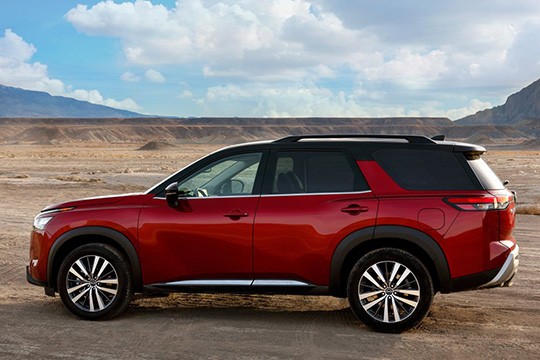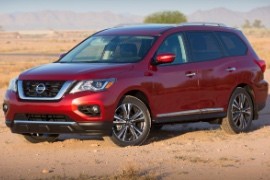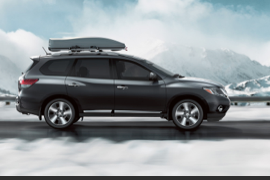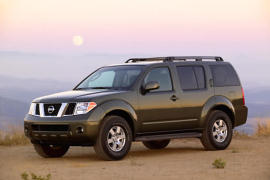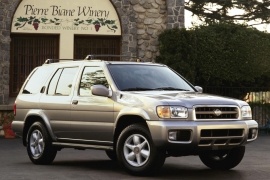NISSAN Pathfinder Models/Series Timeline, Specifications & Photos
First production year: 2001
Engines: Gasoline, , Diesel
Body style: SUV (Sports Utility Vehicle)
Nissan introduced the 2022 Pathfinder in February 2021 at the same time as the Frontier, and it showed a new design language plus a ton of high-tech features.
After thirty-five years on the market, the Pathfinder gathered all the information required to make a stand in its class and tried to be more convincing than anyone else. But every silver lining has its clouds, and that was the engine option. It was a good one, but only one.
From the outside, the Pathfinder was a mix between the rugged look of the Frontier and the soapy one from the Murano. Its front side featured a deep chromed rim for the black, massive grille. The headlights featured two LED daytime running lights and narrow headlamps. At the bottom of the front, wrapped-around bumper, the carmaker installed a metallic shield. From its sides, the designers induced the idea of a floating roof thanks to the black B- and D-pillars, while the C-pillar featured a black upper side.
Inside, the Pathfinder provided room for up to seven passengers. The second and third rows were folding so the vehicle could carry a 4x8 ft plywood. Even though Nissan emphasized that the car didn't forget its utility values, it focused on comfort features. At the front, a new digital dashboard with a 12.3" touch-screen display for the infotainment system welcomed its passengers. The driver enjoyed the 10.8" display for the instrument cluster, and everyone else enjoyed the comfortable ride.
Pathfinder 4WD drive models featured Nissan's all-new Intelligent 4WD with 7-position Drive and Terrain Mode Selector. The 4WD system provided direct coupling, which allowed torque transfer directly on the clutch pack using oil pressure, allowing for confident, immediate take-off in low-traction situations. But Nissan considered installing only one engine option.
A good choice for larger families, the Nissan Pathfinder was a 7-passenger crossover that offered respectable fuel economy and style.
As any other vehicle, the Pathfinder had both strong and weak points, however, the crossover was a little pricey if properly equipped.
For example, the base trim level did not include standard Bluetooth connectivity or even an USB port, features that were standard even on the less expensive competitors on the market. Also, the cargo area was decent, but not the best in the class.
The 2016 model was available in four trim levels: S, SV, SL and Platinum
The S trim level featured standard 18-inch alloy wheels, tri-zone automatic climate control, cruise control, a reclining 50/50 third row and a 6-speaker sound system.
With the SV trim level, the Pathfinder came equipped with automatic headlights, foglights, rear parking sensors, keyless entry, keyless go, a leather-wrapped steering wheel, Bluetooth connectivity, a 7-inch display, a rear-view camera and an upgraded sound system.
Stepping up to the SL trim level, the crossover came with a blind-spot monitoring system with rear cross-traffic alert, a heated steering wheel, leather wrapped and heated front and 2nd row seats.
The top-of-the-range added 20-inch alloys and ventilated front seats. A package designed exclusively for the Platinum added a rear-seat DVD entertainment system.
The first Pathfinder was released in 1986 and was their first truck-inspired SUV.
The exterior design of the Pathfinder changed with every generation, however, for 2013, Nissan reintroduced it as a crossover. The V8 engine available for the previous version was discontinued.
Under the hood, the Pathfinder had a 3.5-liter V6 engine that developed 260 hp. It was mated with a CVT transmission.
The Pathfinder came with a selectable all-wheel-drive mode and offered even better fuel economy than its predecessor did.
Good for off-road as well, the Pathfinder could be locked into the AWD mode to avoid grip loss.
The exterior design was no longer boxy, and the Pathfinder became winder and lower, with 18 inches longer. Still designed like an SUV, the Pathfinder doesn’t resemble much the previous versions.
The cabin of the Pathfinder was designed with premium materials and 60% of the available trim levels included leather upholstery.
The roomy cabin had wood trims and aluminum with metal inserts to spice up the design.
The new version came with a 3rd row to which access was made easy with the foldable seat on the 2nd row.
Nissan gave up the old body-on-frame and the new Pathfinder was built on a unibody chassis.
The starting price of the lowest trim level was around $29.000, while the top of the range, the Platinum was around $47.000.
Nissan introduced a facelifted version for the third generation of the Pathfinder at the 2007 Chicago Auto Show and finally introduced the V8 engine option for the mid-size SUV.
In 2007 few could predict the world financial crisis that followed, and the blooming-looking economy made some automakers dream big. Nissan, for instance, hoped to increase its sales thanks to a redesigned Pathfinder, an SUV that could finally compete against the well-established Grand Cherokee. But then, everything collapsed.
Since the Pathfinder was a body-on-frame vehicle, customers expected it to be able to tow boats or trailers on long distances without tearing a sweat. Moreover, they wanted their SUV to look capable of doing it, and Nissan tried translating that into the bodywork's design. With its squared-looking shape and the rugged appearance of the front fascia, it was on the right path. However, with the flared wheel arches and the concealed door handles for the rear doors, it looked more like a pickup with a topper.
On the other hand, the interior had to be as civilized as possible. It looked like it made it with an option for three-row seating and a comfortable driving position. In addition, the refreshed version featured an upgraded dashboard fitted with a 7" color display and Bluetooth connectivity. The option for a heated steering wheel was much appreciated in cold climate situations. The occupants could relax on long journeys thanks to the reclining middle-row seats, but the third row was not adequate for full-grown adults.
Nissan decided to install the 5.6-liter V8 under the Pathfinder's hood and paired it with a five-speed automatic transmission, which was the most significant upgrade. In other markets, the automaker offered a choice of two turbo-diesel powerplants, including a 3.0-liter V6. Power went to the rear or all corners via a two-speed transfer case, and a locking rear differential was on the options list.
The Nissan’s Pathfinder story started back in 1986 when the first generation was released.
In 2005, the Pathfinder was at its 3rd major redesign, with substantial improvements including interior space and power.
The 2005 Pathfinder returned to the original body-on-frame from the unit-body configuration.
The adventurous attitude of the SUV was easy to spot while looking at the exterior design. Angular lines, prominent fender flares, a standard roof rack and the bold front along with the stepped-out rear bumper gave the Pathfinder a rugged look.
Available in XE, SE, SE Off-Road and LE, with a 2-wheel-drive or a 4-wheel-drive system, the Pathfinder suited most of the users’ needs.
The SE Off-Road trim level was equipped with hill descent and hill start assist, different wheels and suspension and Rancho shock absorbers.
All trim levels shared the 4.0-liter V6 engine, developing 270 hp and 291 pound-feet of torque.
The interior of the Pathfinder was nicely finished and well equipped, even for the base model. In included air conditioning, cruise control, a 6-speaker audio system, keyless remote entry and privacy glass.
Interior space was considerably increased and a 3-rd row seat was available, thus the Pathfinder could accommodate up to 7 people.
The Pathfinder was one of the luxurious SUVs with serious off-road capabilities.
One of the most appreciated midsize SUV on the market, the Nissan Pathfinder offered plenty of power, with both off-road capability and luxury.
While the SUV had a rugged, tough exterior look, the interior was extremely comfortable and classy, offering its occupants plenty of comfort and refinement.
While the old 3.3-liter unit offered enough power to move the Pathfinder, the refreshed model was equipped with a 3.5-liter V6 engine that produced no less than 250 hp and 240 pound-feet of torque.
The Pathfinder had a rear-wheel-drive system or a part-time four-wheel drive. The LE trim level was fitted with an automatic All-Mode four-wheel-drive system.
Three trim levels were available with the 2001 model, the XR, SE and the top-of-the-range, LE.
The XR included standard power mirrors and windows, the SE added the choice of an automatic or a manual transmission and the top-of-the-line LE included a premium Bose sound system, fake wood accents and foglights.
All trim levels included 16-inch wheels and ABS as standard features, while other options included side airbags, a mobile entertainment system and a navigation system, depending on the trim level.
One of the most powerful SUVs in the class, the Pathfinder had lots of goodies as standard.
The Pathfinder was built in Japan before Nissan shifted production to Tennessee.
